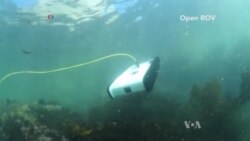What started off as a hunt for sunken treasure turned into the invention of a low-cost, undersea robot, easy enough for anyone to use.
The underwater robot called Trident grew out of a 1970s magazine article about a treasure hunt.
“There was this story that there was a robbery and gold was thrown to the bottom of this underwater cave, and all these treasure hunters and scuba divers, no one was able to get to the bottom…..so Eric [Stackpole] had this big idea that he was going to build this underwater robot to go explore,” explains David Lang, co-founder of OpenROV.
David Lang and Eric Stackpole took a smartphone, and made it waterproof. Thrusters propel Trident through the water.
The little robot, tethered to a buoy, can dive to a depth of 100 meters. It sends a video signal — including temperature, depth and directional information — to an operator, who controls Trident remotely via an Internet connection, and sees what it sees through a virtual reality headset.
The Trident hasn't helped the explorers find gold, but Lang says the real treasure is the chance to help people understand the importance and fragility of our underwater ecosystem.
“The most important thing and first thing is that we have to get people to care…and I think the way to do that is to allow them to engage," said Lang. It’s to give them the tools to actually explore themselves and to feel some sense of ownership in the process.”
The developers hope the low-cost, easy to operate Trident robot will become a powerful research tool. The public campaign to raise operating funds has collected three-quarters of a million dollars and has the potential to make even non-swimmers ocean explorers.











